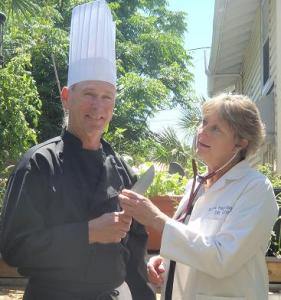Article courtesy of Donna Hargrove, D.O., Nutrition Editor A major vegetable in the south, okra, like corn, is synonymous with summer. It is often grown year-round in southern climates that do not have frost, as it stops producing once temperatures go below 50 degrees. Okra is cultivated in tropical and warm climates. It is among…
Category: Vegetables
Eggplant
Contributed by Donna Hargrove, D.O., Nutrition Editor If you are like most home gardeners in Florida, right now you have a lot of select produce coming in from your garden; eggplant, more eggplant and okra. I posted this article last summer but like to remind folks that eggplant can be used in so many…
SEVEN FAMILIES YOU SHOULD KNOW
From Eat, Drink, and Weigh Less, Authors Mollie Katzen and Walter Willett, M.D. All fruits and vegetables are good for you but no one of either contain everything thing you need for good health.
THINK GREEN!
Article courtesy of Donna Hargrove, D.O., Nutrition Editor If you could get your hands on something non-pharmaceutical positively shown to lower cholesterol and prevent many cancers like colon, lung and prostate, would you take it? This “product” is available and has been for thousands of years. What is it?
Beets
Article courtesy of Donna Hargrove, D.O., Nutrition Editor I write about a lot of powerhouse vegetables, and the beet ranks among the top of the list, but it also has some unique properties unlike other top-of-the-list veggies.
ONIONS
Article courtesy of Donna Hargrove, D.O., Nutrition Editor More than apples, an onion a day may well keep all the doctors away! As it turns out, onions are a super food for health and cancer prevention.
Sweet Potatoes
Article courtesy of Donna Hargrove, D.O., Nutrition Editor This is a vegetable you want to eat often! They are inexpensive, satisfying and a powerhouse of health and nutrition. The sweet potato is one of the oldest and most nutritious of all vegetables, dating back to prehistoric times.
Tomatoes
Article courtesy of Donna Hargrove, D.O., Nutrition Editor Tomatoes, Lycopersicon esculentum, are a member of the nightshade family, a diverse group of over 2,800 species of plants which also includes potatoes, sweet and hot peppers, eggplant, tobacco and morning glory, to name a few. For a long time, tomatoes were not eaten due to the…
GARLIC
Article by Donna Hargrove, D.O., Nutrition Editor Garlic, Allium sativum, is king among the oldest known horticultural crops. The Allium (Latin word for garlic) group are flowering plants known as the onion genus, and contain other related vegetables such as leeks, shallots, chives, onions and scallions. Alliums are native mainly to Asia. Garlic grows wild…
The Amazing Artichoke!
Article by Donna Hargrove, D.O., Nutrition Editor Few vegetables can compete with the artichoke for providing large amounts of phytonutrients, minerals and fiber. Its GI health benefits have been known for centuries, yet the artichoke is still a mystery to many people. History: Humans have been eating artichokes, Cynara scolymus, for more than 3000 years.
Why We Need Vegetables
Article courtesy of Donna Hargrove, D.O., Nutrition Editor Even though everyone knows that vegetables are good for you, 7 out 10 Americans still do not meet the daily recommendations for vegetables. And, Americans are eating less today than 10 years ago. Consumers say their main reasons for not getting enough vegetables are not liking the…
Corn
Peak season: May to October Known scientifically as Zea mays, corn has been a staple food in civilizations dating back 7,000 years. Native to the Americas, it is thought to have originated in either Mexico or Central America. When explorers came to the New World, they found corn growing from Chile to Canada. It was…
Garbanzo Beans (Chick Peas)
Nutrition Factoids Garbanzo beans are a legume known mostly for their concentrated source of protein and fiber – 12.5 grams of fiber per cup – 50% of the daily recommended amount. The majority of the fiber is insoluble, remaining undigested until it reaches the colon, where it is broken down into short chain fatty acids…
Coconut Oil
Good or Bad? Coconut oil has been used as a cooking oil for thousands of years. Then came the anti-saturated fat campaigns and the introduction of polyunsaturated fats, mainly canola, soybean, corn plus their partially hydrogenated counterparts which equals trans fats. A diet high in saturated fats has been causally linked to high cholesterol, heart…
ASPARAGUS
Nutrition Factoids Asparagus is one of the most nutritionally well-balanced vegetables in existence. It leads nearly all produce items in the wide array of nutrients it supplies in significant amounts for a healthy diet.
Five Tips for Adding More Veggies to Your Meals
The Bottom Line Choose more vegetables and fruits. Go for color and variety—dark green, yellow, orange, and red. Why do we need vegetables? Five Quick Tips 1. Keep fruit out where you can see it. That way you’ll be more likely to eat it. Keep it out on the counter or in the front of…
THE FEISTY FENNEL
Fennel has played a supporting role in history (much like its supporting role in recipes). According to Greek mythology, Prometheus smuggled fire to humans inside the hollow wand of a fennel stalk. Roman writer and scientist Pliny the Elder believed in its medicinal properties, and had at least 22 remedies linked to it. Charlemagne made…
